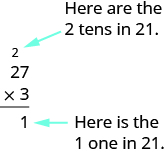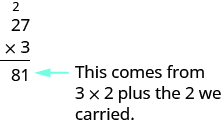| << Chapter < Page | Chapter >> Page > |
| × | 0 | 1 | 2 | 3 | 4 | 5 | 6 | 7 | 8 | 9 |
|---|---|---|---|---|---|---|---|---|---|---|
| 0 | 0 | 0 | 0 | 0 | 0 | 0 | 0 | 0 | 0 | 0 |
| 1 | 0 | 1 | 2 | 3 | 4 | 5 | 6 | 7 | 8 | 9 |
| 2 | 0 | 2 | 4 | 6 | 8 | 10 | 12 | 14 | 16 | 18 |
| 3 | 0 | 3 | 6 | 9 | 12 | 15 | 18 | 21 | 24 | 27 |
| 4 | 0 | 4 | 8 | 12 | 16 | 20 | 24 | 28 | 32 | 36 |
| 5 | 0 | 5 | 10 | 15 | 20 | 25 | 30 | 35 | 40 | 45 |
| 6 | 0 | 6 | 12 | 18 | 24 | 30 | 36 | 42 | 48 | 54 |
| 7 | 0 | 7 | 14 | 21 | 28 | 35 | 42 | 49 | 56 | 63 |
| 8 | 0 | 8 | 16 | 24 | 32 | 40 | 48 | 56 | 64 | 72 |
| 9 | 0 | 9 | 18 | 27 | 36 | 45 | 54 | 63 | 72 | 81 |
What happens when you multiply a number by zero? You can see that the product of any number and zero is zero. This is called the Multiplication Property of Zero.
The product of any number and is
Multiply:
| ⓐ The product of any number and zero is zero. | |
| ⓑ Multiplying by zero results in zero. | |
What happens when you multiply a number by one? Multiplying a number by one does not change its value. We call this fact the Identity Property of Multiplication, and is called the multiplicative identity.
The product of any number and is the number.
Multiply:
| ⓐ The product of any number and one is the number. | |
| ⓑ Multiplying by one does not change the value. | |
Earlier in this chapter, we learned that the Commutative Property of Addition states that changing the order of addition does not change the sum. We saw that is the same as
Is this also true for multiplication? Let’s look at a few pairs of factors.
When the order of the factors is reversed, the product does not change. This is called the Commutative Property of Multiplication.
Changing the order of the factors does not change their product.
Multiply:
| ⓐ Multiply. | |
| ⓑ Multiply. | |
Changing the order of the factors does not change the product.
To multiply numbers with more than one digit, it is usually easier to write the numbers vertically in columns just as we did for addition and subtraction.
We start by multiplying by
We write the in the ones place of the product. We carry the tens by writing above the tens place.

Then we multiply the by the and add the above the tens place to the product. So and Write the in the tens place of the product.

The product is
When we multiply two numbers with a different number of digits, it’s usually easier to write the smaller number on the bottom. You could write it the other way, too, but this way is easier to work with.
Multiply:
| Write the numbers so the digits and line up vertically. | |
| Multiply by the digit in the ones place of | |
| Write in the ones place of the product and carry the tens. | |
| Multiply
by the digit in the tens place of
.
Add the tens we carried. . |
|
| Write the in the tens place of the product. |
Multiply:
| Write the numbers so the digits and line up vertically. | |
| Multiply by the digit in the ones place of | |
| Write the in the ones place of the product and carry the to the tens place.Multiply by the digit in the tens place of . | |
| Add the
tens we carried to get
.
Write the in the tens place of the product and carry the 4 to the hundreds place. |
|
| Multiply
by the digit in the hundreds place of
Add the hundreds we carried to get Write the in the hundreds place of the product and the to the thousands place. |

Notification Switch
Would you like to follow the 'Prealgebra' conversation and receive update notifications?